Are you curious about the calories in a 9 oz steak? Understanding the nutritional nuances of this popular American cut can help you make informed choices when it comes to your meals.
When it comes to the calories in a 9 oz steak, it’s essential to know what you’re eating. The nutritional content of steak can vary depending on the cut and preparation method. Leaner cuts of steak, like grass-fed beef, can be a healthier option. Steak is an excellent source of high-quality protein and provides essential nutrients such as vitamin B12, niacin, selenium, iron, and zinc. It can help preserve muscle mass, support the immune system, and prevent anemia.
While red meat alone is not the cause of heart disease, processed meats pose a greater threat to heart health. Steak is also a low-carb option and contains beneficial nutrients like iron, zinc, vitamins B-6 and B-12. However, it’s important to watch portion sizes and be mindful of the fat and calorie content in steak. The recommended serving size for steak is 3 ounces. It’s also crucial to practice food safety when handling and cooking steak.
Key Takeaways:
- Understanding the calories in a 9 oz steak can help you make informed dietary choices.
- Leaner cuts of steak, like grass-fed beef, can be a healthier option.
- Steak is a great source of high-quality protein and essential nutrients.
- It’s important to watch portion sizes and be mindful of the fat and calorie content in steak.
- Practicing food safety when handling and cooking steak is crucial.
The Nutritional Value of Steak
Steak is not just a delicious meal; it also provides a wealth of nutritional benefits. Packed with high-quality protein and essential nutrients, a 9 oz steak can contribute to a well-balanced diet. It is important to understand the nutritional value that steak brings to the table.
One of the key benefits of steak is its protein content. Protein is crucial for the growth, repair, and maintenance of tissues in our body. A 9 oz steak can provide around 60 grams of protein, which is more than half of the recommended daily intake for most adults.
Additionally, steak is a rich source of important vitamins and minerals. For example, it contains significant amounts of vitamin B12, which is essential for the production of red blood cells and the proper functioning of the nervous system. Steak also provides niacin, selenium, iron, and zinc, all of which play essential roles in supporting overall health and well-being.
| Nutrient | Amount per Serving |
|---|---|
| Protein | Approximately 60 grams |
| Vitamin B12 | 1.5 micrograms |
| Niacin | 6.5 milligrams |
| Selenium | 60 micrograms |
| Iron | 3.5 milligrams |
| Zinc | 8 milligrams |
“Steak provides a powerhouse of nutrients, delivering a significant amount of protein along with essential vitamins and minerals.”
These nutrients have various benefits for our body. For example, iron is essential for the production of hemoglobin, which carries oxygen to our tissues. Zinc supports immune function and wound healing, while selenium acts as an antioxidant, protecting our cells from damage.
By including a 9 oz steak in your diet, you can enjoy the nutritional benefits it offers. Just remember to choose leaner cuts of steak, watch portion sizes, and balance your overall calorie intake to maintain a healthy, well-rounded diet.
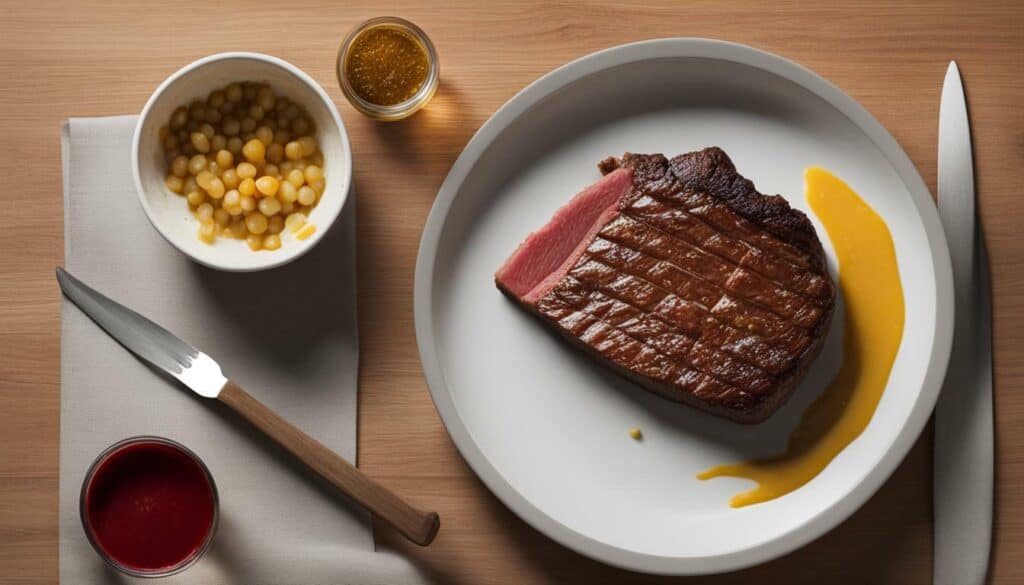
While steak can be a nutritious addition to your diet, it’s important to consider certain health factors when consuming it. Understanding the calorie and fat content of steak can help you make informed choices for your overall health.
When it comes to calories in beef steak, the amount can vary depending on the type of cut and preparation method. Leaner cuts of steak, such as grass-fed beef, can be a healthier option with lower fat content. It’s important to be mindful of portion sizes and choose cuts that fit within your dietary goals.
Steak is an excellent source of high-quality protein, which is essential for building and repairing muscle tissue. It also provides important nutrients like vitamin B12, niacin, selenium, iron, and zinc. These nutrients play a crucial role in supporting various bodily functions, including energy production, immune system health, and red blood cell formation.

By understanding the calorie and fat content of steak, as well as considering other health factors, you can make informed choices when enjoying this delicious protein source. Remember to practice food safety when handling and cooking steak to ensure its quality and minimize the risk of foodborne illnesses.
The Role of Steak in a Low-Carb Diet
Looking to reduce your carbohydrate intake? A 9 oz steak can be a delicious and nutritious addition to a low-carb diet, providing a range of essential nutrients and satisfying your taste buds. Not only is steak a low-carb option, but it also offers several health benefits.
Firstly, steak is a great source of high-quality protein, essential for muscle growth and repair. It contains all the essential amino acids needed by the body. Additionally, steak is rich in iron, which is crucial for transporting oxygen throughout the body and maintaining energy levels.
Furthermore, steak is packed with vitamins and minerals like zinc, which supports a healthy immune system, and vitamin B12, which aids in the formation of red blood cells. These nutrients are vital for overall well-being and can help prevent deficiencies.
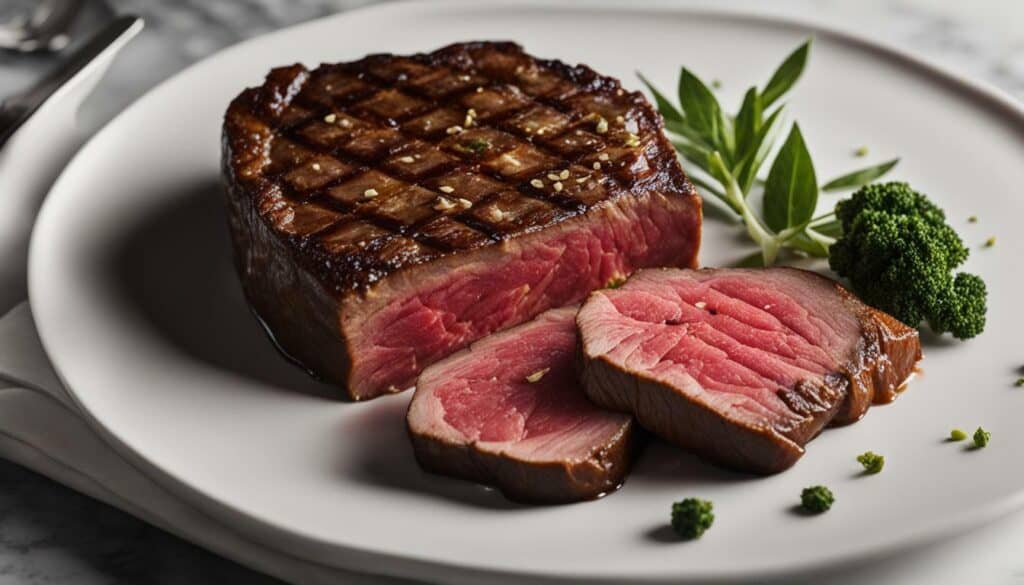
Incorporating steak into your low-carb diet can be a tasty way to reap these benefits. Choose leaner cuts, opt for grass-fed beef whenever possible, and be mindful of portion sizes to keep your calorie and fat intake in check. Remember, balance is key when it comes to maintaining a healthy diet.
So, whether you’re following a low-carb eating plan or simply looking for a delicious and nutrient-rich meal option, a 9 oz steak can be an excellent choice. Enjoy the flavors, savor the nutritional benefits, and make sure to include a variety of other foods in your diet for a well-rounded approach to healthy eating!
Portion Control and Serving Size Recommendations
Understanding the appropriate portion size for your 9 oz steak is vital for managing your calorie intake and maintaining a balanced diet. While steak can be a nutritious choice, consuming excessive amounts can lead to an excess of calories, fat, and sodium. It’s essential to practice portion control to ensure you’re fueling your body with the right amount of nutrients.
When it comes to steak, the recommended serving size is 3 ounces, which is roughly the size of a deck of cards. This portion provides a good balance of protein and other essential nutrients without going overboard on calories. By adhering to this portion size, you can enjoy your steak while still meeting the dietary guidelines for a healthier lifestyle.
Here’s a breakdown of the approximate calorie content of a 9 oz steak based on different cooking methods:
| Cooking Method | Approximate Calorie Content |
|---|---|
| Grilled | 580-630 calories |
| Broiled | 520-570 calories |
| Pan-Seared | 590-640 calories |
Keep in mind that the calorie content can vary depending on the specific cut of steak and the amount of fat present. Choosing leaner cuts or removing excess fat before cooking can help reduce the overall calorie count. Additionally, be mindful of any sauces or toppings you add, as they can contribute to additional calories.
By being aware of portion sizes and making smart choices when it comes to cooking methods and accompaniments, you can enjoy a 9 oz steak while still maintaining a healthy and well-rounded diet.

Food Safety Tips for Handling and Cooking Steak
To fully enjoy the nutritional benefits of your 9 oz steak, it’s crucial to follow food safety guidelines when handling and cooking this delectable cut of meat. By taking the necessary precautions, you can ensure that your steak is not only delicious but also safe to consume. Here are some food safety tips to keep in mind:
1. Storage
Proper storage of your steak is essential to prevent the growth of harmful bacteria. It’s recommended to store raw steak in the refrigerator at a temperature below 40°F (4°C). To maintain its quality, store it in its original packaging or wrap it tightly in plastic wrap or aluminum foil. Avoid leaving it at room temperature for an extended period.
2. Handling
When handling raw steak, it’s crucial to practice good hygiene. Before and after handling, make sure to wash your hands thoroughly with soap and water for at least 20 seconds. Additionally, avoid cross-contamination by using separate cutting boards, utensils, and plates for raw and cooked meat. This helps prevent the transfer of bacteria from raw meat to other foods.
3. Cooking Temperature
Cooking steak to the right temperature is vital to ensure that any harmful bacteria present are destroyed. Use a food thermometer to accurately measure the internal temperature of the steak. The USDA recommends cooking steak to at least 145°F (63°C) for medium-rare, 160°F (71°C) for medium, and 165°F (74°C) for well-done. Make sure to insert the thermometer into the thickest part of the steak without touching the bone.
4. Resting Time
After cooking, allow the steak to rest for a few minutes before slicing or serving. This allows the juices to redistribute, resulting in a juicier and more flavorful steak. During this resting period, the internal temperature of the steak will continue to rise slightly, ensuring that any remaining bacteria are killed.
By following these food safety tips, you can savor your 9 oz steak with peace of mind, knowing that it has been handled and cooked safely. Enjoy your meal!

Table: Food Safety Cooking Temperatures for Steak*
| Steak Doneness | Internal Temperature |
|---|---|
| Medium-Rare | 145°F (63°C) |
| Medium | 160°F (71°C) |
| Well-Done | 165°F (74°C) |
*These temperatures are recommended by the USDA for safe consumption and have been found to effectively destroy harmful bacteria.
Choosing the Right Cut of Steak
Selecting the right cut of steak can have an impact on the calorie and fat content of your 9 oz portion. Let’s explore some popular cuts and their nutritional profiles.
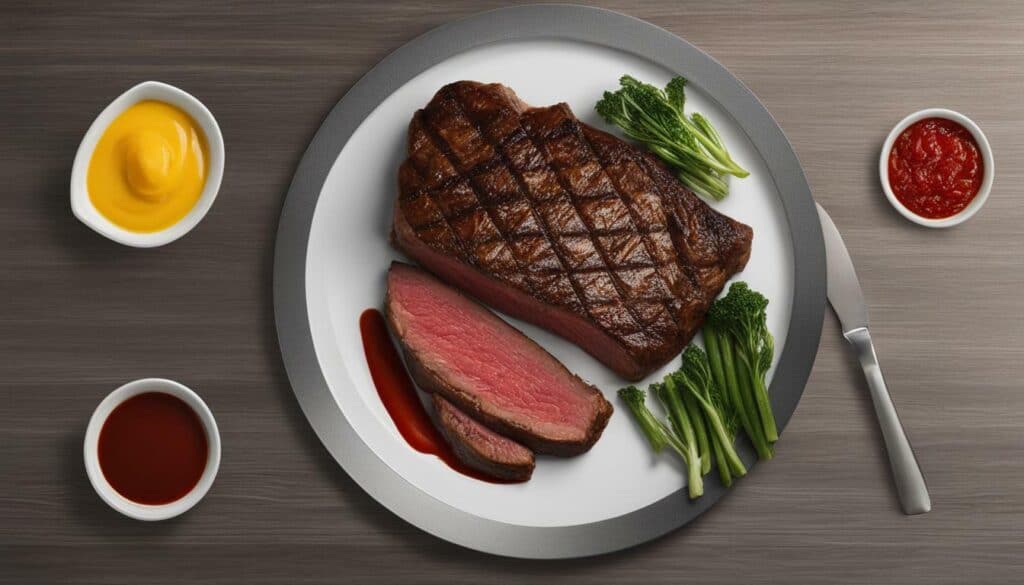
| Cut | Calories (3 oz serving) | Total Fat (g) | Protein (g) |
|---|---|---|---|
| Ribeye | 210 | 16 | 18 |
| Sirloin | 200 | 12 | 22 |
| Tenderloin | 180 | 8 | 26 |
| Filet Mignon | 170 | 6 | 24 |
When it comes to the nutritional profile, the ribeye is a flavorful cut with higher fat content, while the sirloin offers a balance between taste and lower fat content. The tenderloin and filet mignon are leaner cuts that are lower in both calories and fat. These cuts are excellent choices if you’re watching your calorie and fat intake.
Remember, the nutritional values provided are for a 3 oz serving, so if you’re having a 9 oz steak, you’ll need to multiply these numbers accordingly. It’s also important to note that the cooking method and additional ingredients used can affect the overall nutritional content of your steak.
Grass-Fed vs. Grain-Fed Beef
Another consideration when choosing your steak is whether it comes from grass-fed or grain-fed beef. Grass-fed beef is generally leaner and lower in calories compared to grain-fed beef. It also contains higher levels of omega-3 fatty acids and antioxidants, making it a healthier option in terms of nutritional content. Additionally, grass-fed beef is often more environmentally sustainable, as the cattle are raised on a natural diet.
However, it’s important to note that personal preference plays a role in selecting the right cut of steak. Some may prefer the marbling and flavor of grain-fed beef, while others opt for the leaner grass-fed varieties.
Ultimately, choosing the right cut of steak involves considering your dietary needs and preferences. Whether you prefer a juicy ribeye or a tender filet mignon, understanding the nutritional profiles of different cuts can help you make informed choices for a balanced diet.
Grilling vs. Broiling: Impact on Calorie Content
The cooking method you choose for your 9 oz steak can affect not only its flavor but also its overall calorie content. Let’s explore the differences between grilling and broiling when it comes to steak preparation.
When grilling a steak, the heat source is located below the meat, allowing for direct heat transfer. This method allows the fat in the steak to melt and drip away, resulting in a leaner finished product. Additionally, grilling can enhance the natural flavors of the steak, creating a delicious charred exterior and a juicy, tender inside.
On the other hand, broiling involves cooking the steak with the heat source located above the meat. This method exposes the steak to intense heat, resulting in a quick and efficient cooking process. Broiling can produce a crispy exterior and a well-cooked interior, but it may not allow excess fat to drain away as efficiently as grilling.
Ultimately, the calorie content of your 9 oz steak will depend on various factors such as the cut of meat and the amount of marbling. However, both grilling and broiling can be healthy cooking methods that promote the natural flavors of the steak without adding unnecessary calories.
| Steak Cooking Method | Calories per 9 oz serving |
|---|---|
| Grilling | 369-480 calories |
| Broiling | 404-522 calories |
As you can see, the calorie content may vary depending on factors such as the thickness of the steak and the cooking time. It’s important to note that these values are approximate and can differ based on the specific cut and preparation method.
Remember, regardless of the cooking method, moderation is key. Enjoying a 9 oz steak as part of a balanced diet can be a satisfying and nutritious choice. Pair it with a variety of vegetables, whole grains, and other healthy foods to create a well-rounded meal.
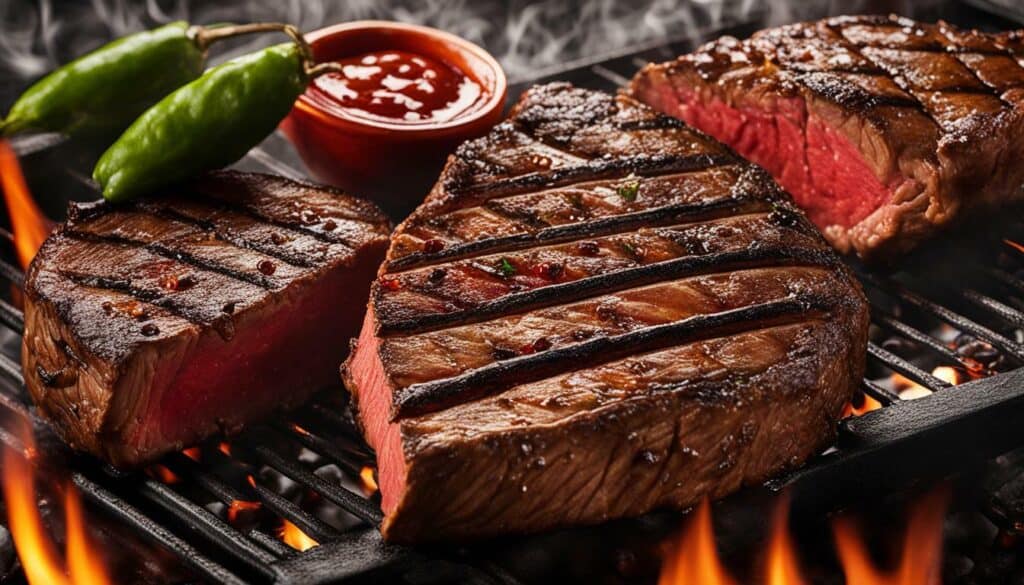
“The cooking method you choose for your 9 oz steak can affect not only its flavor but also its overall calorie content. Let’s explore the differences between grilling and broiling when it comes to steak preparation.”
Grilling: A Healthier Option
Grilling your 9 oz steak can be a healthier option due to the fat that drips away during the cooking process. This can result in a leaner finished product with reduced calorie content. Additionally, the charring that occurs during grilling can enhance the natural flavors of the steak, creating a delicious and satisfying meal.
- Grilling eliminates excess fat: The direct heat from the grill causes the fat in the steak to melt and drip away, resulting in a leaner finished product.
- Enhanced flavors: The high heat and charred exterior achieved through grilling can enhance the natural flavors of the steak, providing a delicious and satisfying dining experience.
While grilling can be a healthier option, it’s still important to practice portion control and choose lean cuts of steak to keep calorie intake in check. Additionally, be mindful of any marinades or sauces used during grilling, as they can add additional calories and fat to your meal.
By being mindful of the cooking method and making informed choices, you can enjoy a delicious and nutritious 9 oz steak while managing your calorie intake.
| Grilling Method | Calories per 9 oz serving |
|---|---|
| Gas grill | 369-404 calories |
| Charcoal grill | 404-444 calories |
| Indoor grill | 444-480 calories |
These values are approximate and can vary depending on factors such as the specific cut of steak and the cooking time.
Broiling: Quick and Efficient
Broiling your 9 oz steak can provide a quick and efficient cooking method that results in a well-cooked and flavorful dish. However, it’s important to note that broiling may not allow excess fat to drain away as efficiently as grilling.
- Intense heat: Broiling exposes the steak to intense heat from above, resulting in a quick and efficient cooking process.
- Crispy exterior: The high heat of broiling can create a crispy exterior on the steak, adding texture and flavor to your meal.
When broiling steak, it’s important to keep a close eye on the cooking time to avoid overcooking. Steak can quickly go from perfectly cooked to overdone when broiled, so be sure to monitor the process and adjust accordingly.
| Broiling Method | Calories per 9 oz serving |
|---|---|
| Standard broiler | 404-481 calories |
| Convection broiler | 481-522 calories |
Again, these values are approximate and can vary based on factors such as the specific cut and thickness of the steak.
In conclusion, the cooking method you choose for your 9 oz steak can impact its flavor and overall calorie content. Grilling allows excess fat to drip away, resulting in a leaner finished product. Broiling provides a quick and efficient cooking method, but may not allow fat to drain as effectively. Regardless of the method you choose, it’s important to practice portion control and choose lean cuts of steak for a healthy and satisfying meal.
The Relationship Between Steak and Heart Health
Concerned about the impact of steak on your heart health? Let’s explore the relationship between steak consumption and cardiovascular well-being. While red meat alone is not the cause of heart disease, it’s important to consider several factors when including steak in your diet.
Steak is a great source of high-quality protein and essential nutrients like iron, zinc, and B-vitamins. These nutrients play a vital role in supporting overall health and well-being. However, it’s crucial to watch portion sizes and be mindful of the fat and calorie content in steak. Excessive intake of saturated fats, commonly found in processed meats, can contribute to an increased risk of heart disease. Instead, opt for leaner cuts of steak, like grass-fed beef, which can be a healthier choice.
In addition to choosing the right cuts, it’s important to practice moderation and balance in your diet. Incorporate a variety of foods, including fruits, vegetables, and whole grains, to ensure you’re getting a wide range of nutrients. This can help support a healthy cardiovascular system and overall well-being.
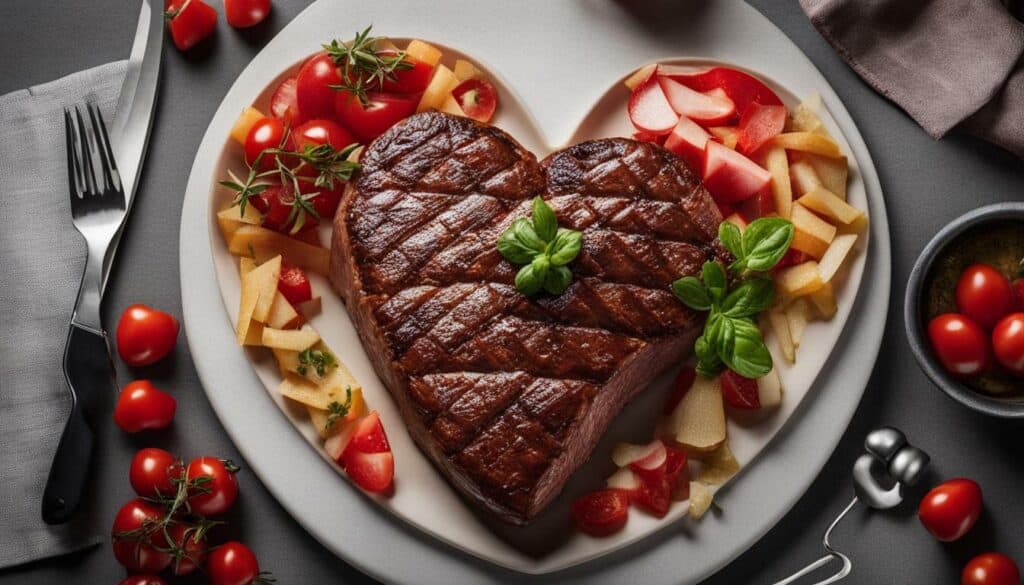
Remember, maintaining a heart-healthy lifestyle involves more than just the individual components of your diet. It’s essential to consider your overall dietary patterns, physical activity levels, and other lifestyle factors. By making informed choices and prioritizing your heart health, you can enjoy steak as part of a well-rounded and balanced diet.
Other Considerations for Steak Lovers
For all the steak lovers out there, it’s essential to consider a few other factors that can contribute to a well-rounded and sustainable diet. While steak can be a delicious and nutritious choice, it’s important to balance your overall food choices and consider the impact of beef consumption on both your health and the environment.
One important consideration is the environmental impact of beef production. The livestock industry is a significant contributor to greenhouse gas emissions, deforestation, and water pollution. To reduce your carbon footprint, you can opt for grass-fed beef, which is produced through more sustainable farming practices. Additionally, incorporating more plant-based meals into your diet can help lower your environmental impact while still allowing you to enjoy steak occasionally.
In addition to sustainability, it’s crucial to be mindful of portion sizes and the overall calorie content of your meals. While steak is a great source of protein, it can also be high in saturated fat and calories. To manage your calorie intake, consider enjoying a smaller portion of steak, accompanied by a generous serving of vegetables or a side salad. This way, you can still savor the flavors of steak while incorporating a variety of nutrients into your meal.
Finally, it’s important to remember that no single food can provide all the necessary nutrients for a healthy diet. While steak does offer essential vitamins and minerals, it’s important to diversify your food choices to ensure you’re meeting all your nutritional needs. Incorporate a variety of fruits, vegetables, whole grains, lean proteins, and plant-based sources of protein into your meals to create a well-rounded and balanced diet.
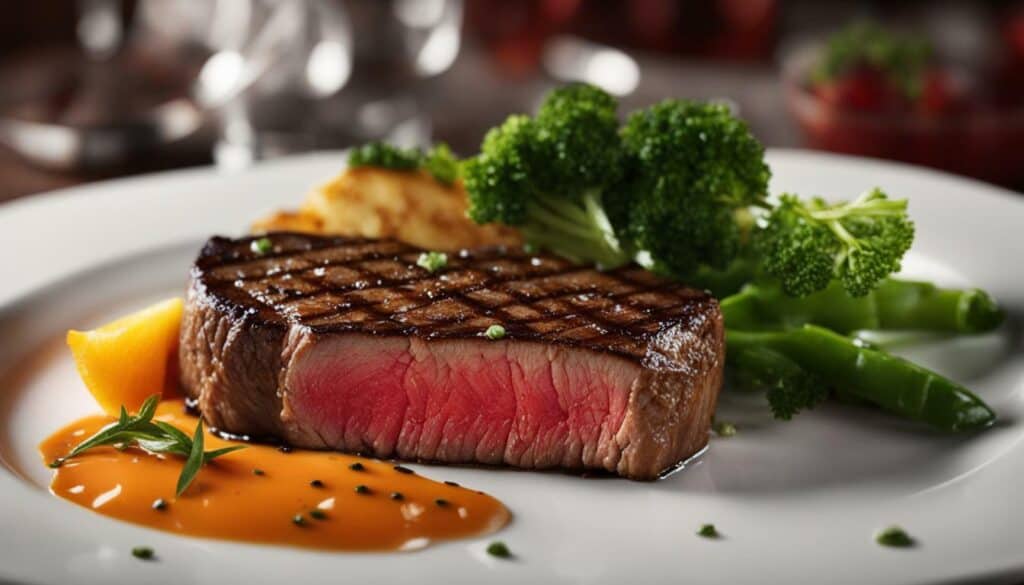
In summary, steak can be a delicious and nutritious addition to your diet, but it’s important to consider other factors to maintain a well-rounded and sustainable eating plan. Keep in mind the environmental impact of beef production, practice portion control to manage calorie intake, and incorporate a variety of foods into your meals for optimal nutrition. By making informed choices and finding the right balance, you can enjoy the benefits of steak while staying mindful of your health and the planet.
Making Informed Choices for a Balanced Diet
Balance is key when it comes to maintaining a healthy diet. Let’s explore how you can make informed choices by incorporating a 9 oz steak into a well-balanced meal plan.
When enjoying a 9 oz steak, it’s important to consider the overall nutritional profile of your meal. In addition to the steak, make sure to include plenty of fruits, vegetables, and whole grains. These foods provide essential vitamins, minerals, and dietary fiber that contribute to overall health and well-being.
To create a balanced plate, aim to fill half of your plate with colorful fruits and vegetables. These nutrient-rich foods offer a wide range of vitamins and minerals that support various bodily functions. Whole grains, such as brown rice or quinoa, can make up another quarter of your plate. These grains are high in fiber, which aids digestion and helps keep you feeling full.
The remaining quarter of your plate can be dedicated to the 9 oz steak. As we discussed earlier, steak is a great source of high-quality protein and essential nutrients. However, it’s important to be mindful of portion sizes and opt for leaner cuts to minimize saturated fat intake.
| Nutrient | Amount per 9 oz steak |
|---|---|
| Protein | 63 grams |
| Iron | 4.5 milligrams |
| Zinc | 7.5 milligrams |
As you can see, a 9 oz steak provides a substantial amount of protein, iron, and zinc. These nutrients are crucial for muscle growth and repair, oxygen transport, and immune system function. By including a variety of food groups in your meal plan, you can ensure that you receive a well-rounded and balanced diet.
I believe that a well-balanced diet is the foundation of good health. By incorporating a 9 oz steak alongside fruits, vegetables, and whole grains, you can create a satisfying and nutritious meal that supports your overall well-being.
In conclusion,
when making choices regarding your diet, it’s important to consider the nutritional value and portion sizes of the foods you consume. A 9 oz steak can be a part of a balanced diet when paired with other nutrient-dense foods. By focusing on moderation, variety, and portion control, you can enjoy the benefits of a delicious steak while maintaining a healthy lifestyle. Remember to always listen to your body’s needs and consult with a healthcare professional or registered dietitian for personalized advice.
Conclusion
Understanding the calories in a 9 oz steak empowers you to make informed decisions about your dietary choices, ensuring a balanced and enjoyable eating experience. When it comes to steak, the nutritional content can vary based on the cut and preparation method. Opting for leaner cuts like grass-fed beef can provide a healthier option, while still offering high-quality protein and essential nutrients such as vitamin B12, niacin, selenium, iron, and zinc. These nutrients play a vital role in muscle preservation, immune system support, and prevention of anemia.
While concerns about heart health are often associated with red meat consumption, it’s important to note that processed meats pose a greater threat than steak alone. In moderation, steak can be part of a heart-healthy diet. Additionally, for those following a low-carbohydrate eating plan, steak is a low-carb option that offers beneficial nutrients like iron, zinc, vitamins B-6, and B-12.
However, when enjoying steak, portion control is key. The recommended serving size is 3 ounces, so being mindful of portion sizes can help manage calorie intake. It’s also essential to practice food safety when handling and cooking steak. Proper storage, handling, and cooking temperatures ensure the safety and quality of your meal.
Ultimately, incorporating steak into a balanced diet means considering the overall nutritional profile of your meals. Focusing on a variety of foods, including fruits, vegetables, and whole grains, alongside a 9 oz steak, can help create a well-rounded and satisfying eating plan. By understanding the calories and nutritional value of steak, you can make informed choices that align with your individual dietary needs and health goals.
FAQ
Q: Are all steaks the same in terms of calorie content?
A: The calorie content of steak can vary depending on the cut and preparation method. Leaner cuts of steak, like grass-fed beef, can be a healthier option.
Q: What nutritional value does steak provide?
A: Steak is an excellent source of high-quality protein and provides essential nutrients such as vitamin B12, niacin, selenium, iron, and zinc. It can help preserve muscle mass, support the immune system, and prevent anemia.
Q: Is steak a low-carb option?
A: Yes, steak is a low-carb option and contains beneficial nutrients like iron, zinc, vitamins B-6, and B-12.
Q: How much steak should I consume?
A: The recommended serving size for steak is 3 ounces. It’s important to practice portion control and be mindful of the fat and calorie content in steak.
Q: What are some food safety tips for handling and cooking steak?
A: When handling and cooking steak, it’s important to practice proper storage, handling, and cooking temperatures to ensure food safety and quality.
Q: How does the cooking method affect the calorie content of steak?
A: Grilling and broiling methods can influence the fat content, as well as the overall taste and texture of your steak.
Q: Is steak consumption linked to heart health?
A: While red meat alone is not the cause of heart disease, processed meats pose a greater threat. Moderation and balanced choices are important for overall cardiovascular health.
Q: What are some other considerations for steak lovers?
A: It’s important to incorporate a variety of foods into your diet and consider the potential environmental impact of beef consumption.
Q: How can I make informed choices for a balanced diet?
A: Consider the overall nutritional profile of your meals, including fruits, vegetables, and whole grains, in conjunction with your steak consumption.

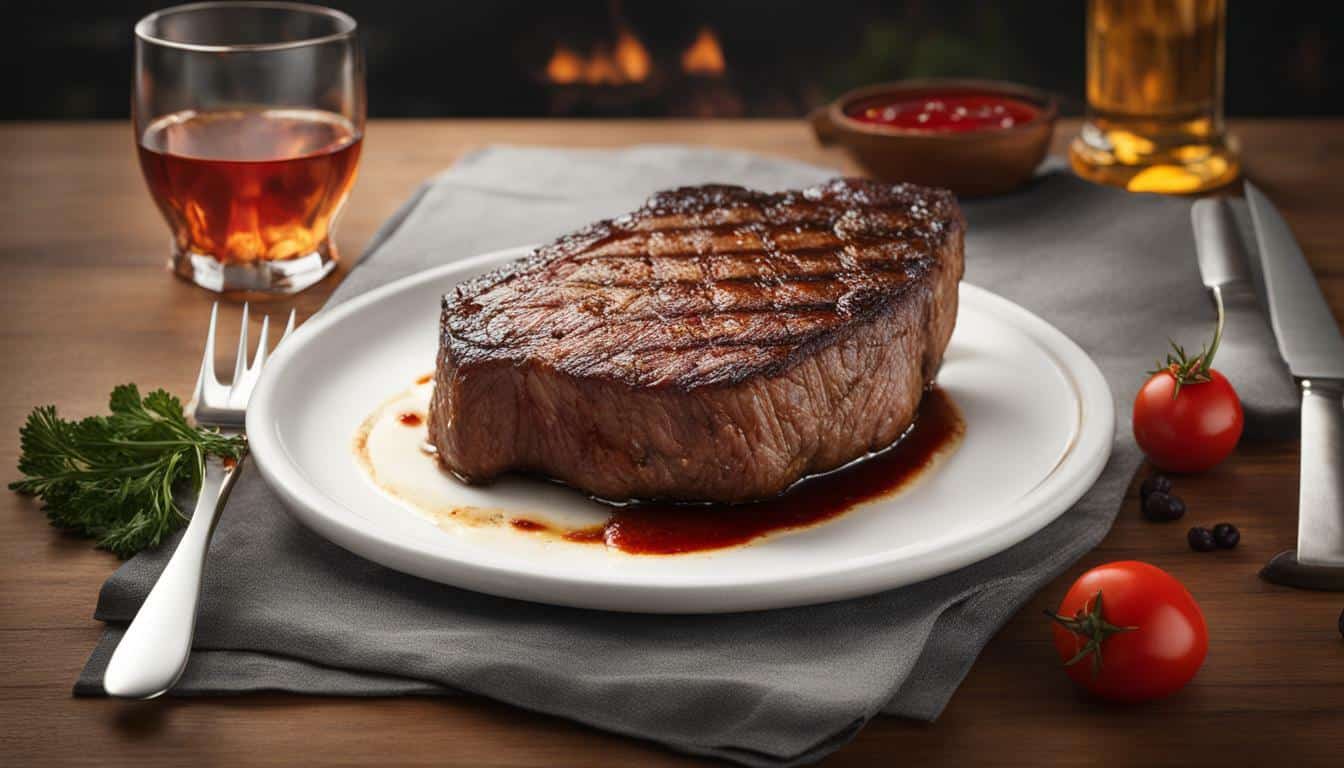



Leave a Reply